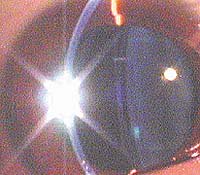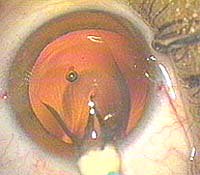To resculpt or implant? That is the question …
The best refractive surgery option embodies minimal risk, quality of vision, minimal pain and rapid rehabilitation, surgeons said in debates at AAO.
ORLANDO, Fla. — As refractive surgery options expand, so expands the ophthalmic surgeon’s task of deciding which procedure is best suited to which patient. Because of the array of possibilities, even when the patient’s refractive error, age, ocular history, financial status and expectations are evaluated, one optimum choice does not always emerge. Defending the decision to reshape the cornea or implant a device such as an intracorneal ring or an anterior or posterior chamber phakic IOL (assuming they are available options) is far from a no-brainer, as a handful of surgeons illustrated at the annual meeting of the American Academy of Ophthalmology. They were participants in a debate aimed at answering the questions: “Resculpt or implant? What is better for our patients?”
Carmen C. Barraquer, MD, had the enviable position of defending laser in situ keratomileusis (LASIK), while Arturo C. Chayet, MD, presented the case for the Intacs intrastromal corneal ring segments (KeraVision, Fremont, Calif.). Robert K. Maloney, MD, suggested that anterior chamber IOLs offer strong advantages over posterior chamber phakic IOLs in cases of high myopia and in some cases of hyperopia, while Ricardo Q. Guimarães, MD, PhD, described why he believes a phakic IOL that is placed behind the iris is inherently preferable.
In defense of LASIK
 ---Dr. Guimarães pointed out that IOLs for correction of high myopia and hyperopia have some significant advantages over corneal sculpting.
---Dr. Guimarães pointed out that IOLs for correction of high myopia and hyperopia have some significant advantages over corneal sculpting.
LASIK’s predictability, reproducibility and adjustability are a few of the attributes that place this refractive procedure head and shoulders above others for low to moderate myopia and hyperopia, according to Dr. Barraquer. That it is an effective treatment for patients ranging from –15 to +7 D puts it in a class by itself, she said. Another plus is that LASIK is easily adjustable. “For instance, hyperopic LASIK easily corrects overcorrections of myopic LASIK with an incredible degree of accuracy,” she said.
The fact that LASIK can both be performed quickly and recovered from speedily also are advantages, she pointed out. “It’s a quick procedure, and it has a quick recovery. The normal time of the surgery is 3 minutes and 30 seconds per eye; and the recovery time is 4 hours. I’ve performed the surgery on ophthalmologists who work with me, and after 4 hours, they are capable of working with me again.”
Most importantly, Dr. Barraquer said, is the procedure’s history. “We have an old and deep medical knowledge on corneal behavior after re-sculpting, and because of the professional ethics of the Barraquers, surgeons have confidence in the results we have published all around the world about the 40-year follow-up on patients who have had a re-sculpting procedure. That gives me a feeling of confidence when I face a patient and recommend this kind of technique,” she said.
Intacs
 ---The primary advantage of posterior chamber phakic IOLs, according to Dr. Guimarães, is the need for a very small incision, usually 3 mm.
---The primary advantage of posterior chamber phakic IOLs, according to Dr. Guimarães, is the need for a very small incision, usually 3 mm.
The advantages of the Intacs for myopia, according to Dr. Chayet, are that “we have a reversible and adjustable procedure with an untouched central cornea; a preservation of positive asphericity with a good possibility of having these patients see 20/15; and no laser is needed, therefore, there is less cost and less fear for the patient.” Some of these advantages apply for hyperopia, as well, he said
Possibly the only drawback of Intacs is that they are limited to use in myopes from –1 to –3 and in hyperopes only up to +2.25 D. However, Dr. Chayet said that out of the 49 million myopes in the United States, one-half of them are between –1 D and –3 D. “As prospective patients learn that the Intacs represent a safe option for the correction of low myopia, and if we choose our patients selectively, we are going to see more and more patients coming into our practices asking for the Intacs,” he said.
With regard to visual rehabilitation, Dr. Chayet pointed out that although LASIK provides much more rapid visual rehabilitation than all other procedures, including the Intacs, when results are compared at 1 month, Intacs surpasses the results from LASIK. Another major benefit is that no laser or microkeratome is needed, making it a procedure that can be performed inexpensively in any minor procedure room, he said.
Anterior, posterior chamber phakic IOLs
In patients with more than 12 D of myopia or 6 D of hyperopia, Dr. Maloney steers clear of LASIK, and instead recommends the Artisan lens implant (Ophtec USA, Boca Raton, Fla.), which lies in front of the pupil and vaults over the crystalline lens. He said that he believes the Artisan lens and other anterior chamber lenses, such as Bausch & Lomb’s (Claremont, Calif.) NuVita lens, are the safest IOLs to use at present in a phakic situation. “They can be inserted with a miotic pupil, which protects the crystalline lens, and the safety results because the lens is far away from vital structures,” he said. “It’s far from endothelium, far from the anterior chamber angle and far from the crystalline lens.”
The advantages of posterior chamber phakic IOLs, according to Dr. Maloney, are that they are far from the corneal endothelium, which preserves endothelial integrity; they’re cosmetically appealing because they are behind the iris; and they are foldable, which the Artisan lens and the NuVita lens are not, making the posterior chamber phakic IOLs capable of insertion through a small incision, he said.
There are disadvantages to posterior chamber phakic IOLs, however, Dr. Maloney said. “To implant these, you have to widely dilate the pupil, and for a beginning surgeon working with an unfamiliar lens, in front of a widely dilated pupil — it’s a bit like handling toxic waste — the smallest contact with that large crystalline lens can cause a cataract. So the learning curve is one in which the surgeon and the patient pay a fairly high price. Reports are that for inexperienced surgeons, the incidence of subcapsular opacities is as high as 30% with these lenses,” he said. “Sizing of these lenses is critical and hasn’t been completely worked out.”
Dr. Guimarães pointed out that IOLs for correction of high myopia and hyperopia have some significant advantages over corneal sculpting, such as “better stability, higher predictability, higher quality of vision, and reversibility.”
The primary advantage of posterior chamber phakic IOLs, according to Dr. Guimarães, is the need for a very small incision, usually 3 mm. “Also, it is LASIK compatible, which means you can do a microkeratome cut after the lens insertion without the risk of touching the endothelium. It gives us a very high quality of vision; it is not associated with halos or glare; and the risk of endothelial cell trauma is small,” he said.
Dr. Guimarães said that although posterior chamber phakic IOLs have been associated with cataracts, this is usually due to surgeon manipulation or to outdated lens models that have now been improved.
“Safety may be further increased by new instrumentation, which will allow us to better determine the lens size. Based on our results, it is an effective and predictable procedure for the correction of high myopia. It is a very delicate technique that demands a very delicate surgeon experienced with foldable plate IOLs using appropriate instruments and the right technique. As much as the endothelium was the Achilles’ heel for the first IOLs, the crystalline lens is the Achilles’ heel of the phakic IOL,” he said.
For Your Information:
- Carmen C. Barraquer, MD, can be reached at Avenida 100 No. 18A-51, Apartado Aereo 90404, Bogota, Colombia; (57) 1-2366033; fax: (57) 1-2563305. Dr. Barraquer has no direct financial interest in any of the products mentioned in this article, nor is she a paid consultant for any companies mentioned.
- Arturo S. Chayet, MD, can be reached at Paseo de Tijuana 406-401, Tijuana, 22320, Mexico; (52) 6-835723; fax: (52) 6-829338. Dr. Chayet has no direct financial interest in any of the products mentioned in this article. He is a paid consultant for KeraVision Inc.
- Robert K. Maloney, MD, can be reached at 10921 Wilshire Blvd., Ste. 900, Los Angeles, CA 90024; (310) 208-3937; fax: (310) 208-0169. Dr. Maloney has no direct financial interest in any of the products mentioned in this article, nor is he a paid consultant for any companies mentioned.
- Ricardo Q. Guimarães, MD, PhD, can be reached at Rua Bernardo Guimarães 1160, Minas Gerais, Belo Horizonte 30-140, MG-34000, Brazil; (55) 31-289-2030; fax: (55) 31-289-2150. Dr. Guimarães has no direct financial interest in any of the products mentioned in this article, nor is he a paid consultant for any companies mentioned.
- Bausch & Lomb Surgical can be reached at 555 W. Arrow Highway, Claremont, CA 91711; (800) 423-1871; fax: (909) 399-1525.
- KeraVision Inc. can be reached at 48360 Milmont Drive, Fremont, CA 94538; (510) 353-3000; fax: (510) 353-3030.
- Ophtec USA can be reached at 6421 Congress Ave., Ste. 112, Boca Raton, FL 33487; (561) 989-8767; fax: (561) 989-9744.
